Abstract
Abundant evidence suggests that sleep might be altered during infectious disease, although the relationship between sleep and infectious disease has never been examined systematically. To address this issue, we determined the effects of Staphylococcus aureus infection on rabbit sleep. Rabbits inoculated intravenously with S. aureus demonstrated the expected physiological changes consistent with a state of infectious disease (e.g., lymphopenia, neutrophilia, and fever), as well as time-dependent changes in sleep patterns. The sleep changes were characterized initially by increases in (i) the time spent in slow-wave sleep, (ii) the electroencephalographic slow-wave amplitudes during slow-wave sleep, and (iii) the duration of individual bouts of slow-wave sleep. At 20 to 36 h after inoculation, sleep responses fell to levels below corresponding control values for 6 to 12 h. At 6 to 10 h after inoculation, rapid-eye-movement sleep was suppressed and remained at low levels throughout the remainder of the 48-h recording period. These effects of bacterial infection on sleep were attenuated by antibiotic (cephalothin) therapy. Inoculation with killed bacteria produced similar changes in sleep and other physiological parameters, although significantly higher numbers of organisms were required to produce equivalent responses. We postulate that changes in sleep may represent an adaptive response of the host to infectious disease.
Full text
PDF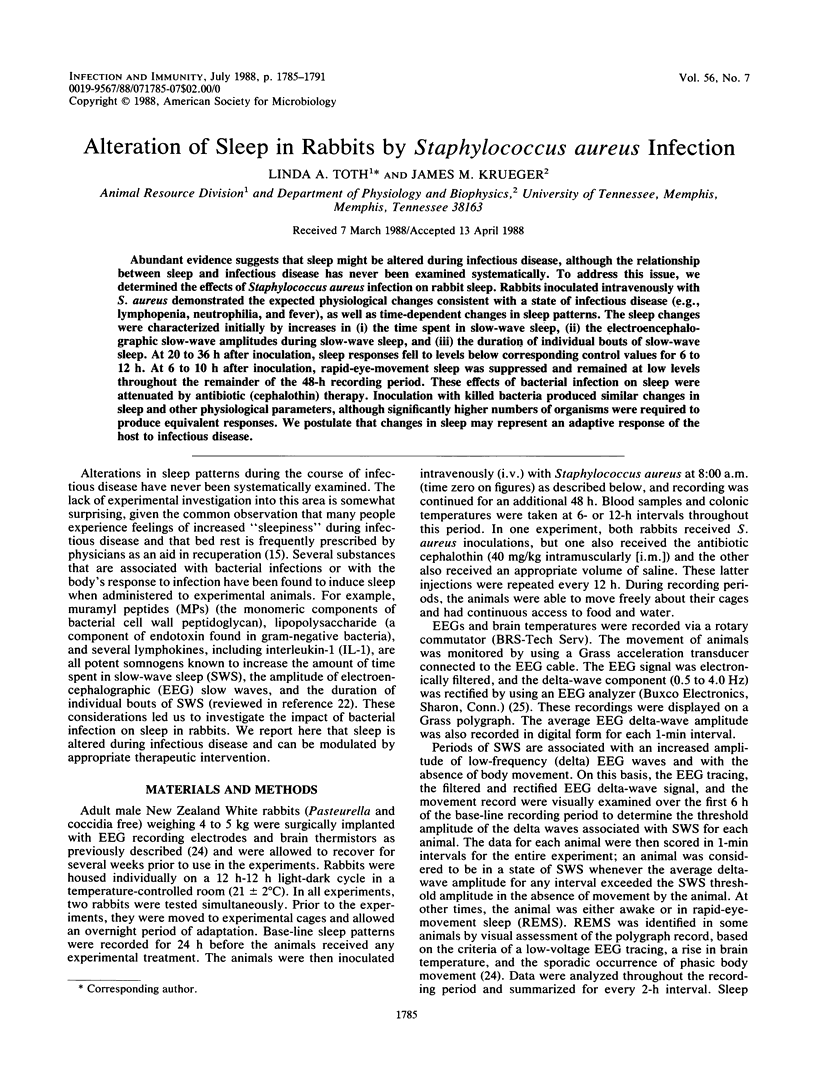
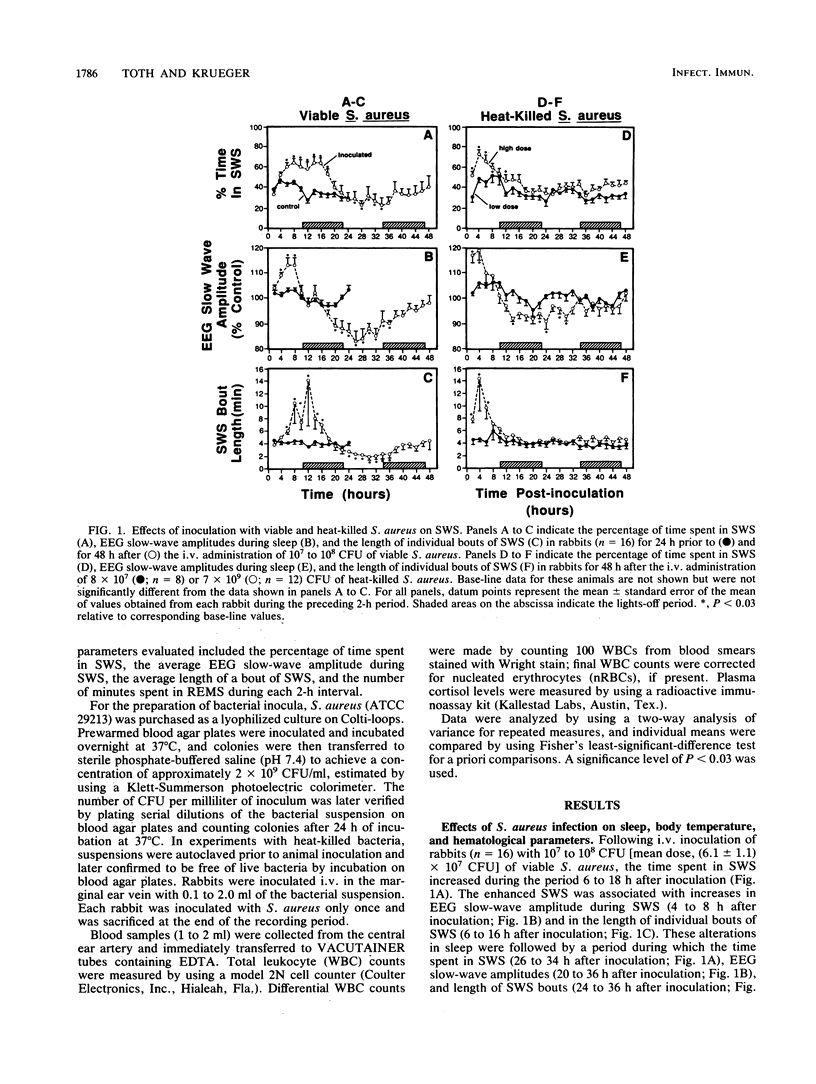
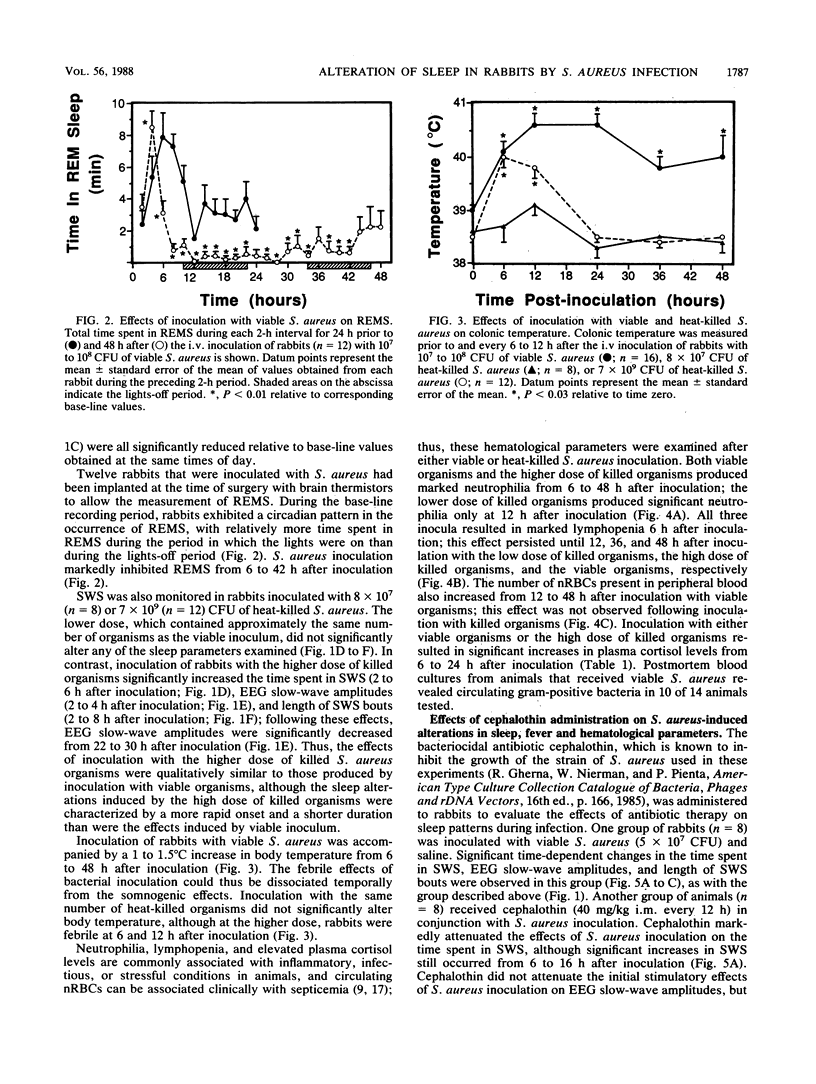
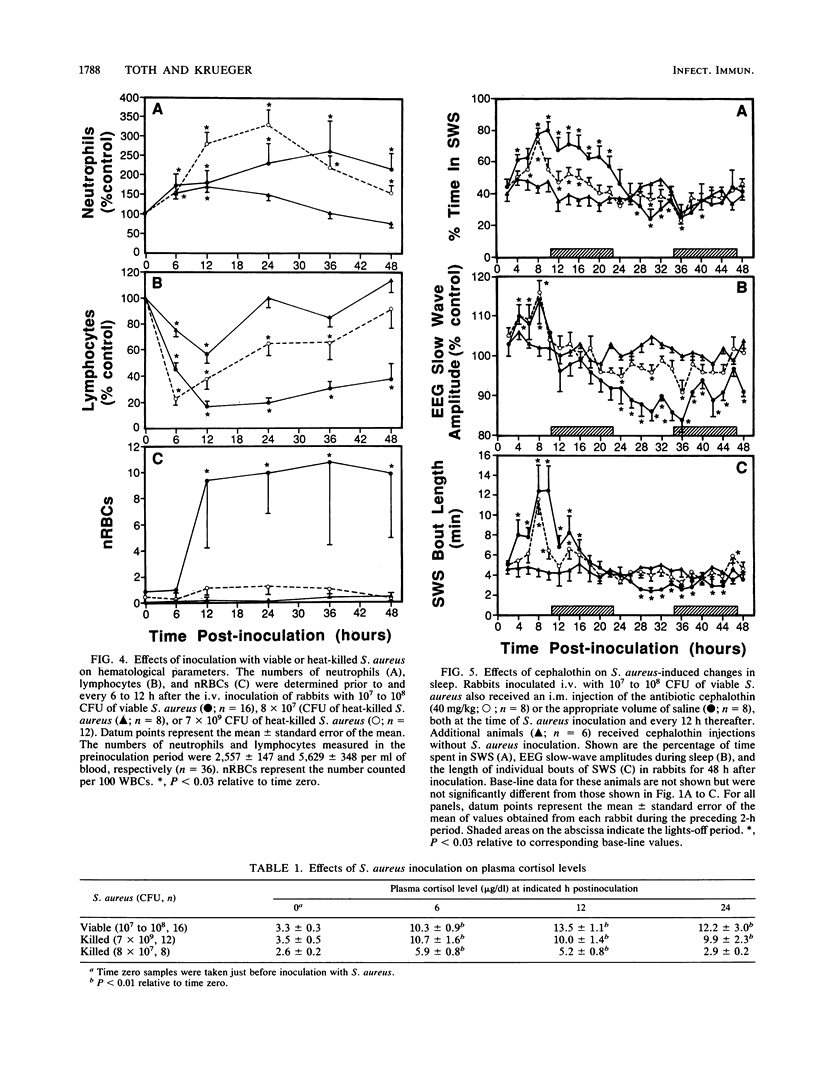
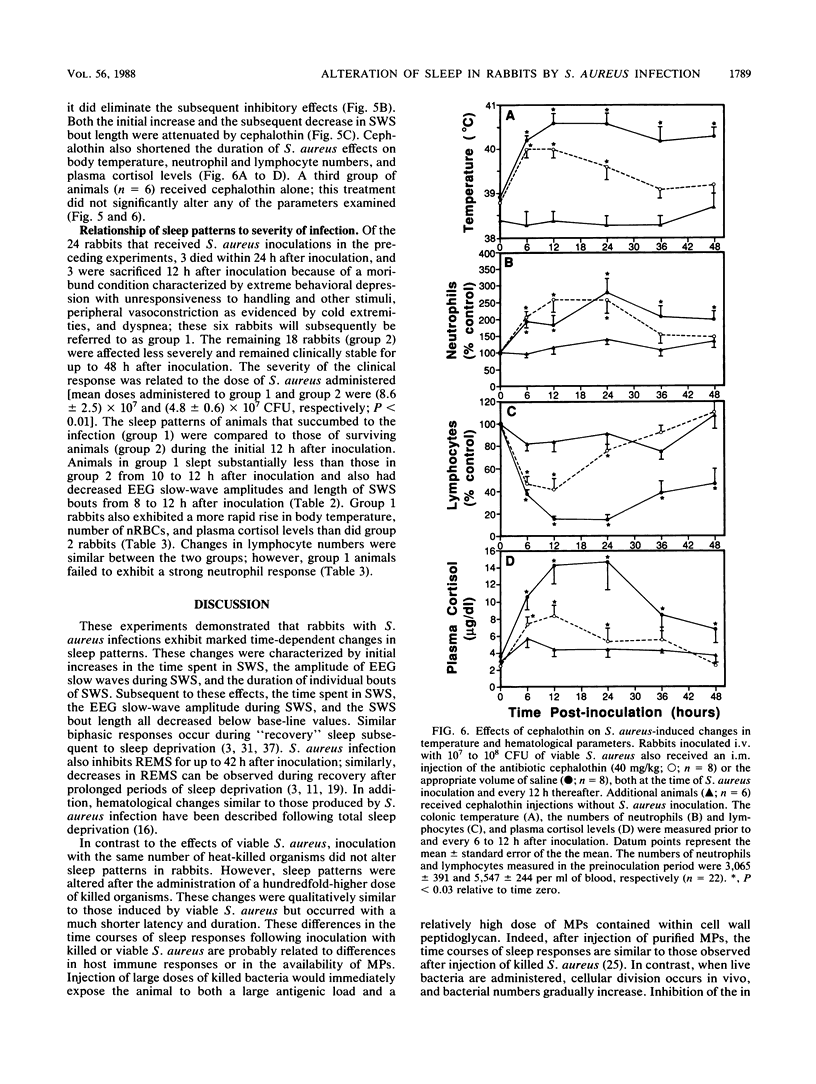
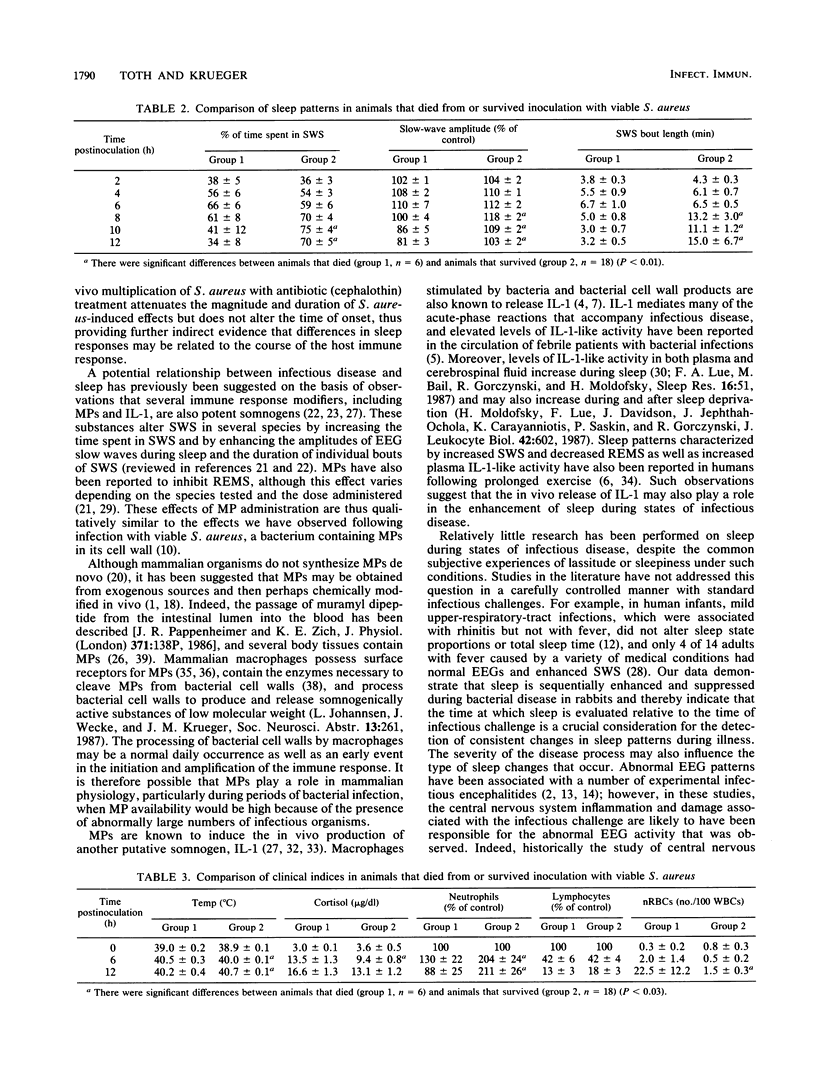
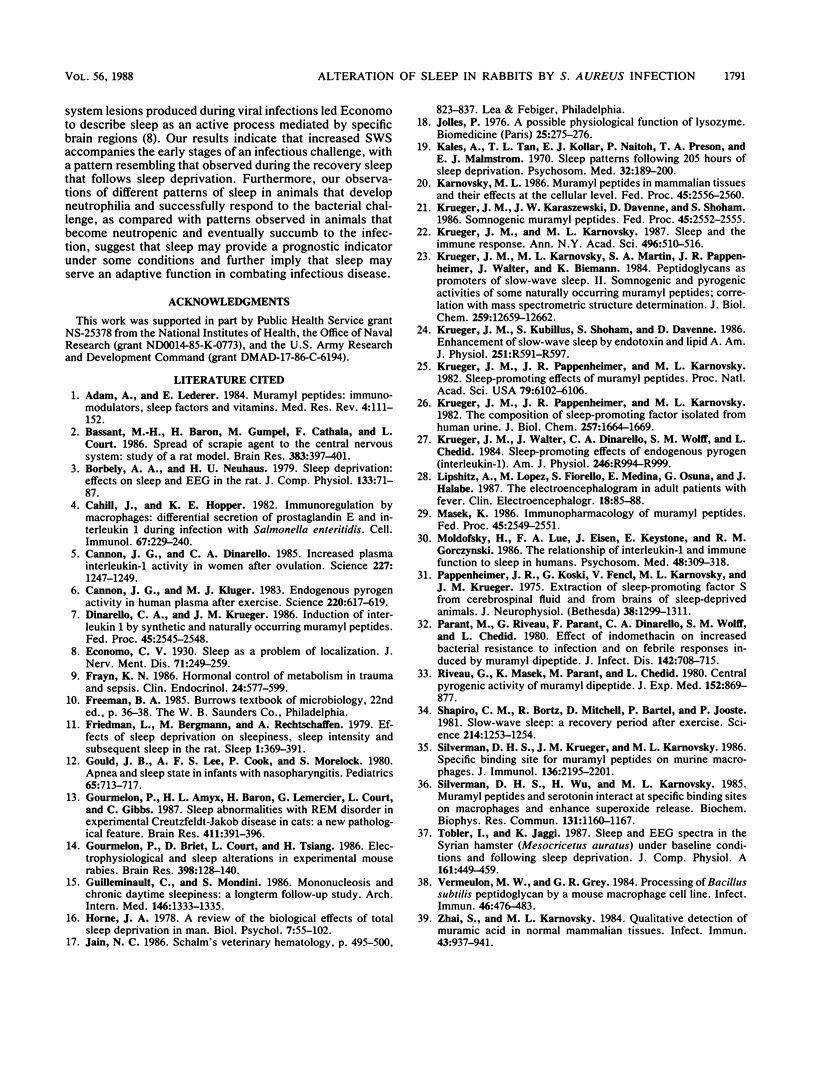
Selected References
These references are in PubMed. This may not be the complete list of references from this article.
- Adam A., Lederer E. Muramyl peptides: immunomodulators, sleep factors, and vitamins. Med Res Rev. 1984 Apr-Jun;4(2):111–152. doi: 10.1002/med.2610040202. [DOI] [PubMed] [Google Scholar]
- Bassant M. H., Baron H., Gumpel M., Cathala F., Court L. Spread of scrapie agent to the central nervous system: study of a rat model. Brain Res. 1986 Sep 24;383(1-2):397–401. doi: 10.1016/0006-8993(86)90048-x. [DOI] [PubMed] [Google Scholar]
- Cahill J., Hopper K. E. Immunoregulation by macrophages: differential secretion of prostaglandin E and interleukin 1 during infection with Salmonella enteritidis. Cell Immunol. 1982 Mar 1;67(2):229–240. doi: 10.1016/0008-8749(82)90216-7. [DOI] [PubMed] [Google Scholar]
- Cannon J. G., Dinarello C. A. Increased plasma interleukin-1 activity in women after ovulation. Science. 1985 Mar 8;227(4691):1247–1249. doi: 10.1126/science.3871966. [DOI] [PubMed] [Google Scholar]
- Cannon J. G., Kluger M. J. Endogenous pyrogen activity in human plasma after exercise. Science. 1983 May 6;220(4597):617–619. doi: 10.1126/science.6836306. [DOI] [PubMed] [Google Scholar]
- Dinarello C. A., Krueger J. M. Induction of interleukin 1 by synthetic and naturally occurring muramyl peptides. Fed Proc. 1986 Oct;45(11):2545–2548. [PubMed] [Google Scholar]
- Frayn K. N. Hormonal control of metabolism in trauma and sepsis. Clin Endocrinol (Oxf) 1986 May;24(5):577–599. doi: 10.1111/j.1365-2265.1986.tb03288.x. [DOI] [PubMed] [Google Scholar]
- Friedman L., Bergmann B. M., Rechtschaffen A. Effects of sleep deprivation on sleepiness, sleep intensity, and subsequent sleep in the rat. Sleep. 1979 Summer;1(4):369–391. doi: 10.1093/sleep/1.4.369. [DOI] [PubMed] [Google Scholar]
- Gould J. B., Lee A. F., Cook P., Morelock S. Apnea and sleep state in infants with nasopharyngitis. Pediatrics. 1980 Apr;65(4):713–717. [PubMed] [Google Scholar]
- Gourmelon P., Amyx H. L., Baron H., Lemercier G., Court L., Gibbs C. J., Jr Sleep abnormalities with REM disorder in experimental Creutzfeldt-Jakob disease in cats: a new pathological feature. Brain Res. 1987 May 19;411(2):391–396. doi: 10.1016/0006-8993(87)91093-6. [DOI] [PubMed] [Google Scholar]
- Gourmelon P., Briet D., Court L., Tsiang H. Electrophysiological and sleep alterations in experimental mouse rabies. Brain Res. 1986 Nov 19;398(1):128–140. doi: 10.1016/0006-8993(86)91258-8. [DOI] [PubMed] [Google Scholar]
- Guilleminault C., Mondini S. Mononucleosis and chronic daytime sleepiness. A long-term follow-up study. Arch Intern Med. 1986 Jul;146(7):1333–1335. [PubMed] [Google Scholar]
- Horne J. A. A review of the biological effects of total sleep deprivation in man. Biol Psychol. 1978 Sep;7(1-2):55–102. doi: 10.1016/0301-0511(78)90042-x. [DOI] [PubMed] [Google Scholar]
- Jollès P. A possible physiological function of lysozyme. Biomedicine. 1976 Sep 30;25(8):275–276. [PubMed] [Google Scholar]
- Kales A., Tan T. L., Kollar E. J., Naitoh P., Preston T. A., Malmstrom E. J. Sleep patterns following 205 hours of sleep deprivation. Psychosom Med. 1970 Mar-Apr;32(2):189–200. doi: 10.1097/00006842-197003000-00005. [DOI] [PubMed] [Google Scholar]
- Karnovsky M. L. Muramyl peptides in mammalian tissues and their effects at the cellular level. Fed Proc. 1986 Oct;45(11):2556–2560. [PubMed] [Google Scholar]
- Krueger J. M., Karaszewski J. W., Davenne D., Shoham S. Somnogenic muramyl peptides. Fed Proc. 1986 Oct;45(11):2552–2555. [PubMed] [Google Scholar]
- Krueger J. M., Karnovsky M. L., Martin S. A., Pappenheimer J. R., Walter J., Biemann K. Peptidoglycans as promoters of slow-wave sleep. II. Somnogenic and pyrogenic activities of some naturally occurring muramyl peptides; correlations with mass spectrometric structure determination. J Biol Chem. 1984 Oct 25;259(20):12659–12662. [PubMed] [Google Scholar]
- Krueger J. M., Karnovsky M. L. Sleep and the immune response. Ann N Y Acad Sci. 1987;496:510–516. doi: 10.1111/j.1749-6632.1987.tb35808.x. [DOI] [PubMed] [Google Scholar]
- Krueger J. M., Kubillus S., Shoham S., Davenne D. Enhancement of slow-wave sleep by endotoxin and lipid A. Am J Physiol. 1986 Sep;251(3 Pt 2):R591–R597. doi: 10.1152/ajpregu.1986.251.3.R591. [DOI] [PubMed] [Google Scholar]
- Krueger J. M., Pappenheimer J. R., Karnovsky M. L. Sleep-promoting effects of muramyl peptides. Proc Natl Acad Sci U S A. 1982 Oct;79(19):6102–6106. doi: 10.1073/pnas.79.19.6102. [DOI] [PMC free article] [PubMed] [Google Scholar]
- Krueger J. M., Pappenheimer J. R., Karnovsky M. L. The composition of sleep-promoting factor isolated from human urine. J Biol Chem. 1982 Feb 25;257(4):1664–1669. [PubMed] [Google Scholar]
- Krueger J. M., Walter J., Dinarello C. A., Wolff S. M., Chedid L. Sleep-promoting effects of endogenous pyrogen (interleukin-1). Am J Physiol. 1984 Jun;246(6 Pt 2):R994–R999. doi: 10.1152/ajpregu.1984.246.6.R994. [DOI] [PubMed] [Google Scholar]
- Lifshitz A., López M., Fiorelli S., Medina E., Osuna G., Halabe J. The electroencephalogram in adult patients with fever. Clin Electroencephalogr. 1987 Apr;18(2):85–88. [PubMed] [Google Scholar]
- Masek K. Immunopharmacology of muramyl peptides. Fed Proc. 1986 Oct;45(11):2549–2551. [PubMed] [Google Scholar]
- Moldofsky H., Lue F. A., Eisen J., Keystone E., Gorczynski R. M. The relationship of interleukin-1 and immune functions to sleep in humans. Psychosom Med. 1986 May-Jun;48(5):309–318. doi: 10.1097/00006842-198605000-00001. [DOI] [PubMed] [Google Scholar]
- Pappenheimer J. R., Koski G., Fencl V., Karnovsky M. L., Krueger J. Extraction of sleep-promoting factor S from cerebrospinal fluid and from brains of sleep-deprived animals. J Neurophysiol. 1975 Nov;38(6):1299–1311. doi: 10.1152/jn.1975.38.6.1299. [DOI] [PubMed] [Google Scholar]
- Parant M., Riveau G., Parant F., Dinarello C. A., Wolff S. M., Chedid L. Effect of indomethacin on increased resistance to bacterial infection and on febrile responses induced by muramyl dipeptide. J Infect Dis. 1980 Nov;142(5):708–715. doi: 10.1093/infdis/142.5.708. [DOI] [PubMed] [Google Scholar]
- Riveau G., Masek K., Parant M., Chedid L. Central pyrogenic activity of muramyl dipeptide. J Exp Med. 1980 Oct 1;152(4):869–877. doi: 10.1084/jem.152.4.869. [DOI] [PMC free article] [PubMed] [Google Scholar]
- Sen Z., Karnovsky M. L. Qualitative detection of muramic acid in normal mammalian tissues. Infect Immun. 1984 Mar;43(3):937–941. doi: 10.1128/iai.43.3.937-941.1984. [DOI] [PMC free article] [PubMed] [Google Scholar]
- Shapiro C. M., Bortz R., Mitchell D., Bartel P., Jooste P. Slow-wave sleep: a recovery period after exercise. Science. 1981 Dec 11;214(4526):1253–1254. doi: 10.1126/science.7302594. [DOI] [PubMed] [Google Scholar]
- Silverman D. H., Krueger J. M., Karnovsky M. L. Specific binding sites for muramyl peptides on murine macrophages. J Immunol. 1986 Mar 15;136(6):2195–2201. [PubMed] [Google Scholar]
- Silverman D. H., Wu H., Karnovsky M. L. Muramyl peptides and serotonin interact at specific binding sites on macrophages and enhance superoxide release. Biochem Biophys Res Commun. 1985 Sep 30;131(3):1160–1167. doi: 10.1016/0006-291x(85)90212-8. [DOI] [PubMed] [Google Scholar]
- Tobler I., Jaggi K. Sleep and EEG spectra in the Syrian hamster (Mesocricetus auratus) under baseline conditions and following sleep deprivation. J Comp Physiol A. 1987 Aug;161(3):449–459. doi: 10.1007/BF00603970. [DOI] [PubMed] [Google Scholar]
- Vermeulen M. W., Gray G. R. Processing of Bacillus subtilis peptidoglycan by a mouse macrophage cell line. Infect Immun. 1984 Nov;46(2):476–483. doi: 10.1128/iai.46.2.476-483.1984. [DOI] [PMC free article] [PubMed] [Google Scholar]


